In an age where customer expectations are higher than ever, the need for efficient and effective help desk support is undeniable. The implementation of help desk best practices can significantly impact an organization’s ability to handle customer service operations, address common customer queries promptly, and deliver a seamless support experience. Beyond these, the strategy behind a help desk influences the overall efficiency of support processes.
Drawing from our extensive exposure to user experience (UX) with help desk support, we’ve identified practices that are crucial for businesses aiming to excel in customer service operations. Let’s get right into the help desk tips of selecting software, automating processes, and ultimately, their practical application.
Table of contents
- 1. Carefully select and use the right help desk software for your business
- 2. Provide a single point of contact
- 3. Ensure a user-friendly interface
- 4. Automate help desk processes for smooth workflow
- 5. Incorporate Service Level Agreements (SLA)
- 6. Create dedicated help desk groups
- 7. Implement a multi-tier architecture
- 8. Utilize canned responses
- 9. Offer a customer self-service portal for a personalized experience
- 10. Build an extensive knowledge base and FAQ section
- 11. Apply data-driven insights to boost help desk effectiveness
- 12. Set up third-party integrations for enhanced functionality
- 13. Perform regular customer satisfaction surveys
- 14. Provide 24/7 support to increase customer satisfaction
- 15. Ensure data security and compliance
- 16. Extend help and support via multiple communication channels
- 17. Prioritize the well-being of your help desk team members
- Conclusion
1. Carefully select and use the right help desk software for your business
Choosing the appropriate help desk software is pivotal for any business looking to enhance its customer service operations. This tool should meet your current needs while also being scalable for future demands. Some critical factors to consider are:
- Help desk type
- The feature set and available customizations
- Automation options
- Security
- Ease of implementation and use
- Channel integrations
- Self-service capabilities
- Affordable pricing that fits your budget
- Software scalability
- Responsive customer support
To truly capitalize on your investment, consider LiveAgent’s robust feature set, which was specially designed to streamline your customer service workflows. As a head’s up, it’s always a good idea to verify the latest help desk software options and updates to ensure your selection fits your organization best.
2. Provide a single point of contact
Establishing your help desk as a single point of contact (SPOC) simplifies the customer support process, making it easier for customers to get the help they need without navigating through multiple channels. This approach reduces confusion and ensures consistency in support, which consequently leads to significantly enhancing customer satisfaction and loyalty. Furthermore, focusing on key customer journey touchpoints streamlines communication and provides a more cohesive customer experience.
Consumers often become frustrated when they have to repeat the same issue to different agents. A SPOC strategy can alleviate this frustration by improving response times and maintaining consistency across interactions. Additionally, it simplifies the training processes for support staff, as they only need to familiarize themselves with a single, unified method of communication and problem resolution. A SPOC strategy can also help foster a deeper understanding of customer issues as representatives can track interactions more comprehensively.
3. Ensure a user-friendly interface
Ensuring a user-friendly interface is not just about making a system easy to use; it’s about creating an environment where both customers and agents can interact with your help desk support software effortlessly. A well-designed interface minimizes the learning curve, enabling new users to adapt quickly and existing users to work more efficiently.
Streamlined navigation plays a critical role in this, as it allows agents to swiftly find the information they need, significantly cutting down on response times and elevating the overall quality of support provided, particularly in handling service requests.
Take LiveAgent’s interface as a prime example—it’s built with the user’s experience at its core. Its dashboard is logically organized, ensuring that agents have immediate access to the tools and information that matter most. For instance, features like a unified inbox allow agents to manage conversations across multiple channels from a single point, reducing the need to switch between different applications and interfaces.
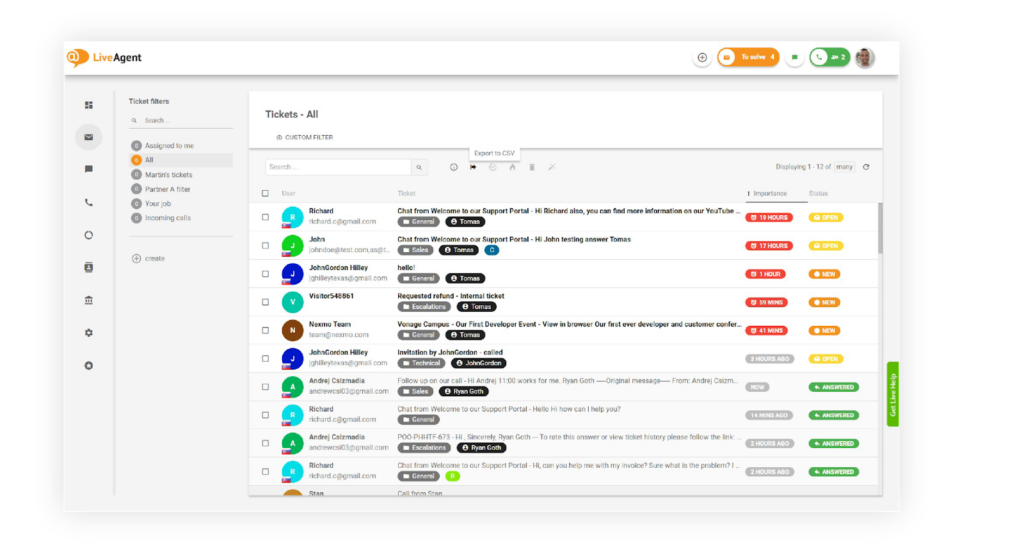
Another aspect that highlights the importance of a user-friendly interface is the integration of search functionalities. Agents can quickly locate past interactions, customer information, or solutions to common issues without having to sift through databases or ask colleagues for assistance manually. This capability not only speeds up the resolution process but also ensures that customers receive accurate and consistent support.
4. Automate help desk processes for smooth workflow
Leveraging the full spectrum of automation options provided by your chosen customer service software is key to optimizing help desk operations. These automation tools are designed to enhance workflow efficiency while simultaneously ensuring a seamless service experience for both customers and agents.
Following IT help desk best practices, one of the most impactful uses of automation is automatic ticket routing. This function ensures that incoming tickets are swiftly allocated to the appropriate team or agent based on predefined criteria such as issue type, customer priority, or agent expertise. This automation eliminates the bottleneck and inefficiencies associated with manual sorting and distribution, allowing your team to focus on resolution rather than administration.
Additionally, automated responses can significantly enhance customer interaction by providing immediate acknowledgments, estimated resolution times, or even direct solutions for common queries. This instant communication can greatly improve customer satisfaction by setting accurate expectations and reducing perceived wait times.
5. Incorporate Service Level Agreements (SLA)
Implementing Service Level Agreements (SLAs) within your help desk empowers you to establish clear, measurable performance benchmarks for your support team.
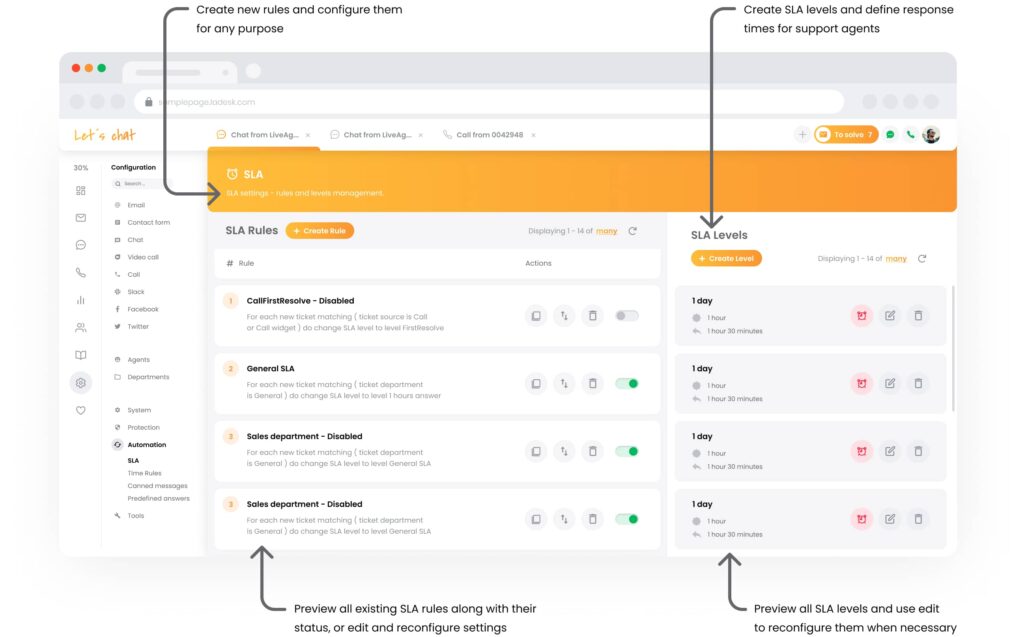
How does this work in practice?
By incorporating SLAs, you create a structured framework that outlines specific expectations for response and resolution times. Simultaneously, you foster a culture of accountability and efficiency within your support operations, adhering to a strict service desk policy. Here’s how SLAs can transform your help desk’s functionality:
- Defining response times: Set explicit timelines for when customers can expect an initial response. This clarity aids your team in prioritizing tasks and effectively managing their workload. Such an approach ensures that no customer query goes unnoticed, regardless of priority levels.
- Establishing resolution times: Beyond the first reply, resolution time SLAs commit your team to solving issues within a predetermined period. This encourages quick and effective solutions, enhancing customer satisfaction.
- Allocating resources efficiently: Clear SLAs allow you to predict better and manage the distribution of resources. Understanding the ticket volume that must be resolved within specific time frames allows for strategic staffing and resource allocation.
- Improving service quality: SLAs are like your service scorecard, reminding you to keep raising the bar. Regularly checking how well you’re meeting these agreements helps you find areas where you can train and improve your processes.
- Enhancing customer trust: By consistently meeting or exceeding SLA standards, you demonstrate a commitment to reliable and professional service. This reliability is key to building long-term customer loyalty and trust.
SLAs are not just about setting targets; they are about creating a structured approach to customer service that emphasizes timeliness, accountability, and continuous improvement. Implementing these agreements into your help desk strategy ensures that both your team and your customers clearly understand what to expect, leading to improved service experiences, stronger relationships with your customer base, and enhanced overall satisfaction.
6. Create dedicated help desk groups
Did you know that forming dedicated help desk groups can significantly elevate your customer service capabilities? It’s a strategic move, particularly important for globally active businesses. These groups should consist of well-trained agents proficient in using help desk tools and skilled in communication and customer service, in line with established help desk standards. Adequate staffing ensures timely responses across various time zones and during peak periods, significantly enhancing customer satisfaction and support quality.
By focusing on specialized training and appropriate agent capacity, businesses can better manage customer inquiries and maintain high service standards. Common topics to cover in these training sessions could include:
- Problem-solving workshops
- Communication skills development
- Technical training
- Customer psychology
If you want to incorporate some different methods of training, some effective examples you can add are role-playing exercises, gamification, peer mentoring, and long-term learning programs.
7. Implement a multi-tier architecture
A multi-tier architecture for help desk support helps in efficiently managing different levels of customer inquiries, from basic questions to complex issues. This structure typically includes:
- Tier 1: Basic support for common questions and issues.
- Tier 2: More specialized support requiring deeper technical knowledge.
- Tier 3: Advanced support for complex and critical issues, often involving senior technicians or product engineers.
This tiered approach ensures that customer queries are directed to the most appropriate level of support, optimizing resolution times and resource utilization.
8. Utilize canned responses
Canned responses are pre-formulated replies designed to address frequently asked questions or resolve common issues swiftly. These predefined answers help maintain consistency in responses across different agents, ensuring that all customers receive reliable and uniform support. By incorporating canned responses into their workflow, agents can save significant time, allowing them to handle a higher volume of inquiries without sacrificing the quality of service.
Additionally, when used judiciously, canned responses can prevent agent fatigue by reducing the need for repetitive typing and mental effort. If you want higher job satisfaction and better overall performance, this is definitely one way to enhance your help desk team’s efficiency.
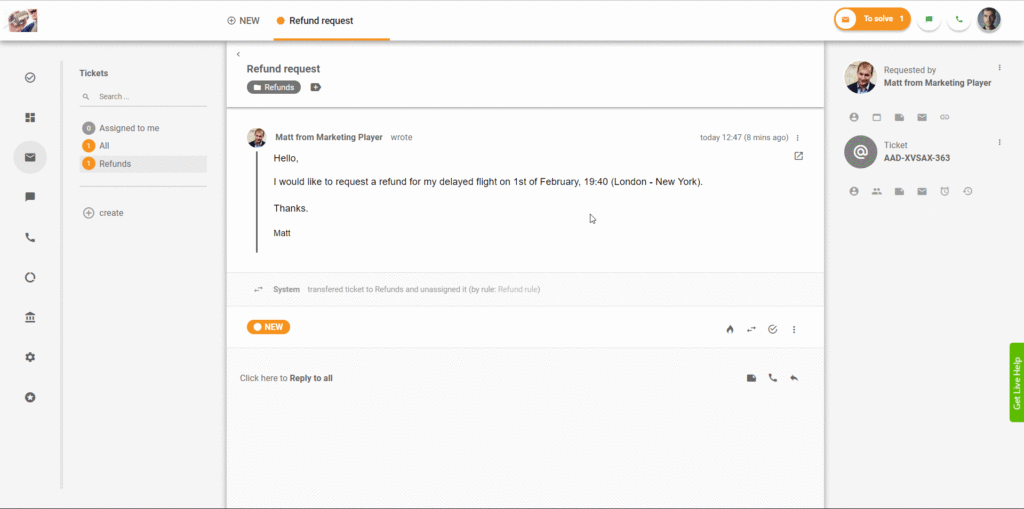
9. Offer a customer self-service portal for a personalized experience
It’s been found that 73% of customers prefer the possibility of solving issues independently, using an online portal for self-service instead of speaking to a representative. Self-service options empower customers to find answers to their questions without direct assistance from a support agent. An up-to-date customer self-service portal featuring FAQs, how-to guides, and troubleshooting tips will give customers what they want, ultimately improving customer satisfaction scores while reducing the workload on your help desk team.
By investing in top-notch self-service software like LiveAgent, you can make this whole process even smoother. It fits right in with your current customer service setup, ensuring everything runs super efficiently and user-friendly. Good software keeps things tidy and easy to find, giving users more control and making them happier overall.
10. Build an extensive knowledge base and FAQ section
A significant percentage of consumers—91%—would use an online knowledge base articles if it were easily accessible and tailored to their needs. This statistic underscores the high value customers place on being able to access information independently and conveniently. Furthermore, 81% of customers engage with FAQs, help centers, or other self-service online resources before reaching out, which illustrates the extensive use and importance of these tools in customer service strategies today.
A well-structured knowledge bases and FAQ section are indispensable for any effective help desk. They provide customers with instant access to solutions and information, reducing the need for direct contact with support agents. Regularly updating these resources ensures that the information remains relevant and useful
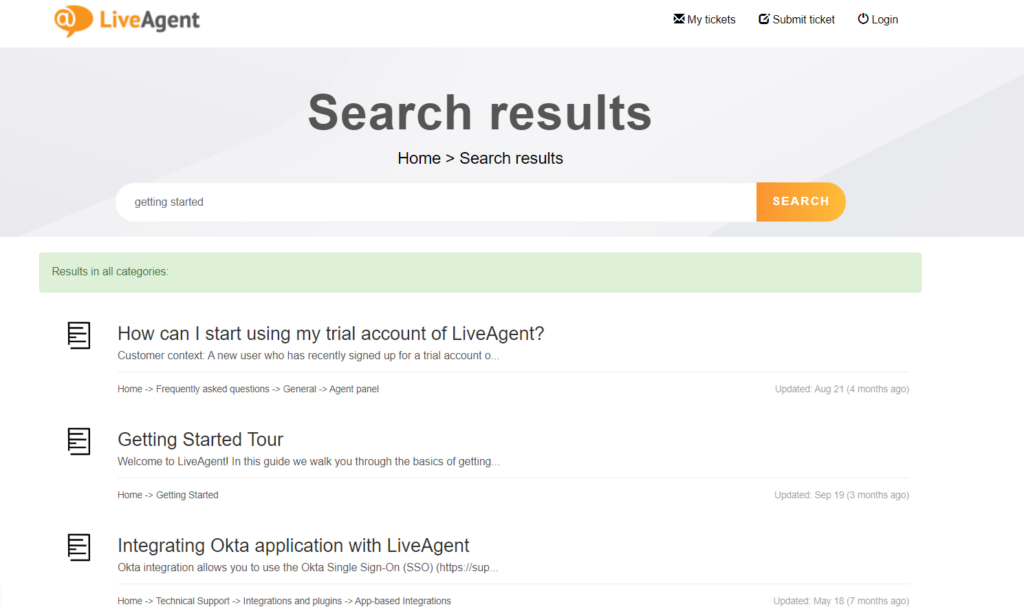
11. Apply data-driven insights to boost help desk effectiveness
Leveraging data-driven insights is paramount for elevating the effectiveness of your help desk operations. While specific metrics are critical, the broader focus should be on analyzing help desk analytics to identify trends, areas for improvement, and successes. This approach enables you to make informed decisions about strategy adjustments, training needs, and resource allocation. Observing long-term data trends allows you to predict future challenges and opportunities, allowing for proactive rather than reactive management.
Additionally, data insights can highlight the efficiency of communication channels, guiding you to optimize interactions based on customer preferences and behaviors. By integrating comprehensive analytics into daily operations, you not only streamline workflows, but also enhance customer satisfaction and team morale, ultimately fostering a culture of continuous improvement and strategic insightfulness in your organization.
12. Set up third-party integrations for enhanced functionality
Integrating your help desk or service desk software with third-party applications can significantly extend its capabilities, offering more seamless workflows and an enriched feature set. It also allows for better data synchronization across platforms, reducing the risk of errors and ensuring that customer information is always up-to-date. This connectivity enhances overall operational efficiency, enabling teams to deliver faster and more accurate customer service.
LiveAgent supports a wide range of over 200 integrations, enhancing its versatility and utility. The most popular integrations among our users include Slack, Shopify, WooCommerce, and Magento. By leveraging these integrations, businesses can provide a more cohesive and efficient service experience.
13. Perform regular customer satisfaction surveys
There is always room for gauging the effectiveness of your help desk support – conducting customer satisfaction surveys is a straightforward yet powerful way to do so. Integrating a continuous improvement philosophy into your feedback loop can significantly enhance service quality. For example, gathering feedback can illuminate the specific training needs of help desk staff, directly linking customer insights to targeted developmental programs.
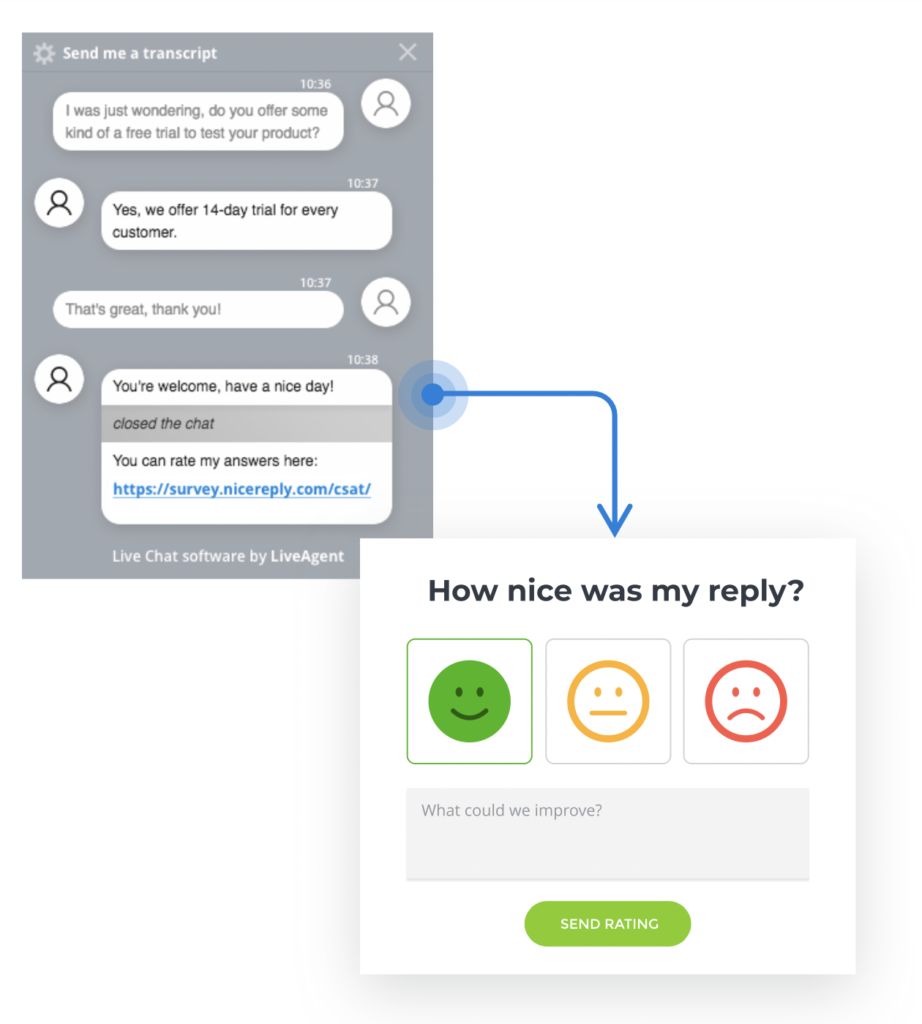
For crafting effective surveys, consider using our customer satisfaction survey questions as a guide. You can identify areas for improvement, engage team members in the process, and foster a culture of excellence and adaptability all in one go.
14. Provide 24/7 support to increase customer satisfaction
75% of customers expect a quick response from service agents, but in reality, the average response time from a customer service team is a whole 12 hours. This disconnect between expectation and reality is a wake-up call for businesses. This is where 24/7 support fits as a best help desk practice.
Having 24/7 online support enables businesses to offer faster replies and sends a clear message that a company is dedicated to addressing customer needs swiftly and efficiently, ultimately creating stronger customer satisfaction and loyalty.
Customer support automation can reduce response times and improve service quality by instantly handling routine inquiries, allowing agents to focus on more complex customer needs. Additionally, 96% of consumers say the quality of customer service is important in their choice of loyalty to a brand.
15. Ensure data security and compliance
There’s no denying that data security and compliance are a must these days, where data breaches can severely impact customer trust and company reputation. Implementing stringent security measures and adhering to regulatory standards are essential for safeguarding sensitive information. Without robust security measures, businesses risk data theft, legal consequences, and severe operational disruptions.
LiveAgent’s help desk security feature emphasizes solid protection for your customer service operations. It utilizes HTTPS encryption to secure data transmissions, ensuring that sensitive information remains private.
Additionally, LiveAgent supports custom security policies, including IP address restrictions, to further safeguard access. This comprehensive security framework is designed to protect both your data and your customers’ privacy reliably.
16. Extend help and support via multiple communication channels
Multi-channel support offers customers the flexibility to reach out via their preferred methods: social media, email, phone, or live chat. Engaging with brands on social media platforms is becoming increasingly standard for users.
75% of Twitter users, 59% of Facebook users, and 34% of Instagram users have reached out to engage with brands through the respective platforms.
Survey by Khoros
This makes it essential for businesses to be accessible and meet their customers where they are.
Software like LiveAgent allows you to manage tickets from Facebook, Instagram, Twitter, Viber, and WhatsApp from a single place. This conveniently streamlines communication from multiple channels and allows social media support to be leveraged as needed.
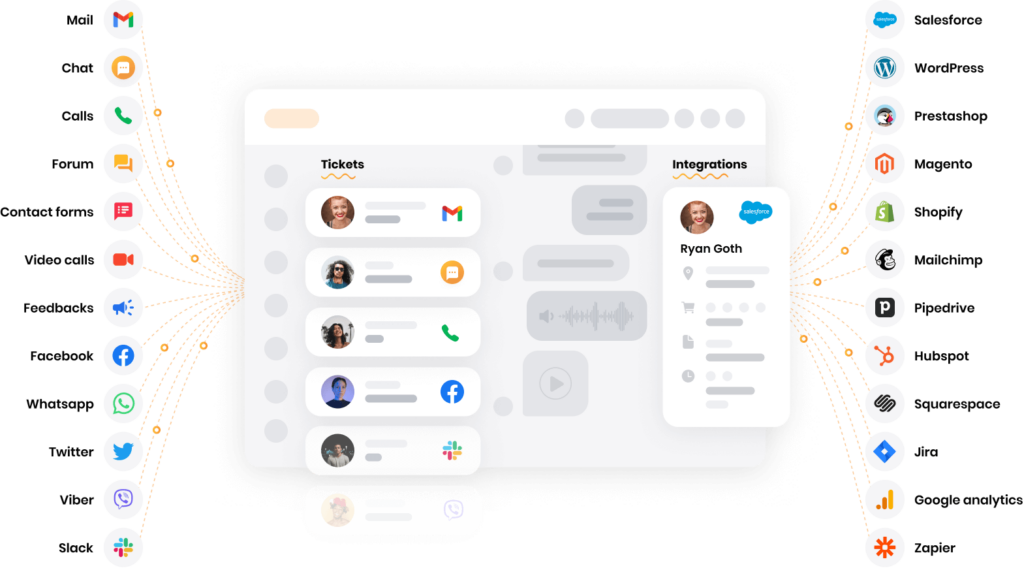
17. Prioritize the well-being of your help desk team members
Delivering exceptional service cannot be fulfilled without satisfied help desk agents – a.k.a, customers’ primary point of interaction. The best you can do is to keep agents motivated and engaged by setting realistic performance targets, offering a fair reward system, valuing their feedback, and implementing strategies to prevent burnout and overwork.
Some ways to combat these effects are:
- Regular breaks and flexible scheduling: Encourage agents to take regular breaks to recharge, and whenever possible, offer flexible scheduling to help them manage work-life balance better.
- Provide mental health resources: Make mental health resources and support easily accessible. Consider offering programs like stress management workshops or access to counseling services.
- Foster a supportive work environment: Create a culture that promotes open communication and peer support. Encourage team interactions and provide a platform for agents to share their experiences and coping strategies.
- Professional development opportunities: Offer training and development opportunities to help agents enhance their skills and feel more invested in their work, reducing feelings of stagnation and frustration.
- Monitor workloads: Regularly assess your help desk agents’ workloads to ensure they are manageable. Use automated tools to distribute tickets evenly and avoid overloading any single agent.
- Recognize and reward efforts: Acknowledge your agents’ hard work through recognition and rewards. This boosts morale while reinforcing their value to the organization.
Implementing these strategies can help mitigate the effects of burnout and overwork, leading to a more satisfied and productive help desk staff.
Conclusion
Implementing the 17 help desk best practices for 2025 can transform your customer service operations into a powerhouse of efficiency and customer satisfaction. These practices, grounded in extensive experience, emphasize the importance of choosing adaptable help desk software, establishing a single point of contact, and ensuring user-friendly interfaces. Automating routine processes and integrating Service Level Agreements (SLAs) streamline operations and set clear performance benchmarks. Moreover, expanding support across multiple communication channels and offering 24/7 service cater to the modern consumer’s expectations.
By adopting these strategies, businesses can enhance agent productivity, improve customer experiences, and foster enduring customer loyalty. Start your journey to apply these practices today by using LiveAgent’s 30-day free trial.
Elevate your business capabilities with our cutting-edge help desk software.
Start your free 30-day trial today and see the difference!
Frequently Asked Questions
How should you choose the right help desk software for your company?
Select help desk software that aligns with your company's specific needs and scalability requirements. Consider factors such as the software’s ability to integrate with existing systems, its range of features (like automation and multi-channel support), user-friendliness, and cost. Prioritize options that offer strong customer support and regular updates.
Why should you automate help desk processes?
Automating help desk processes streamlines operations, reduces the workload on agents, and minimizes human error. Automation can speed up response times for common inquiries with pre-set answers, route tickets to the appropriate agents automatically, and manage repetitive requests efficiently, enhancing overall customer service quality.
How can I be a good help desk technician?
To excel as a help desk technician, develop strong problem-solving skills, be patient, and communicate clearly. Stay knowledgeable about the latest technology relevant to your field. Prioritize customer satisfaction by listening actively and empathizing with users, while efficiently resolving their issues.
What is basic helpdesk workflow?
A basic helpdesk workflow involves ticket creation, ticket assignment, issue resolution, and closure. When a customer submits a request, it is logged as a ticket. This ticket is then assigned to an appropriate technician. The technician resolves the issue and provides the customer with a solution, after which the ticket is closed.
Provide excellent customer service
Discover unparalleled customer support with LiveAgent's all-in-one software. Benefit from 24/7 service, a free trial without a credit card, and seamless integration across 130+ ticketing features. Enhance your business with fast setup, AI assistance, live chat, and more. Choose LiveAgent for exceptional service and satisfied customers.
Smart customer satisfaction software
Boost customer satisfaction in 2025 with LiveAgent! Deliver personalized, 24/7 support on every channel. Free trial, no credit card needed.

 Български
Български  Čeština
Čeština  Dansk
Dansk  Deutsch
Deutsch  Eesti
Eesti  Español
Español  Français
Français  Ελληνικα
Ελληνικα  Hrvatski
Hrvatski  Italiano
Italiano  Latviešu
Latviešu  Lietuviškai
Lietuviškai  Magyar
Magyar  Nederlands
Nederlands  Norsk bokmål
Norsk bokmål  Polski
Polski  Română
Română  Русский
Русский  Slovenčina
Slovenčina  Slovenščina
Slovenščina  简体中文
简体中文  Tagalog
Tagalog  Tiếng Việt
Tiếng Việt  العربية
العربية  Português
Português 




